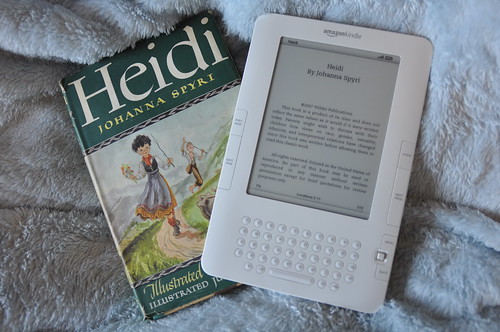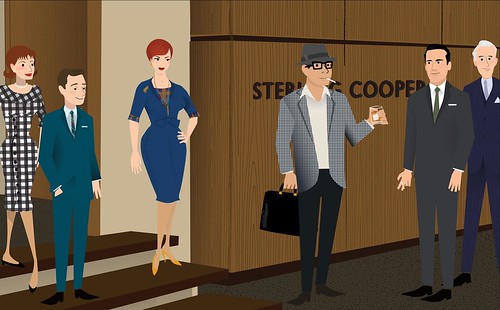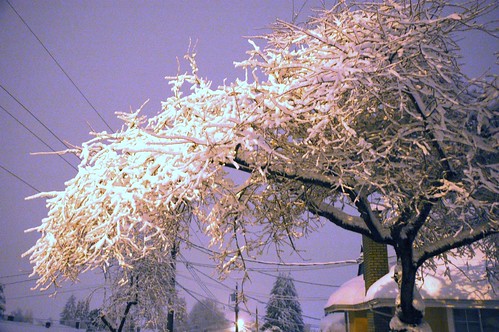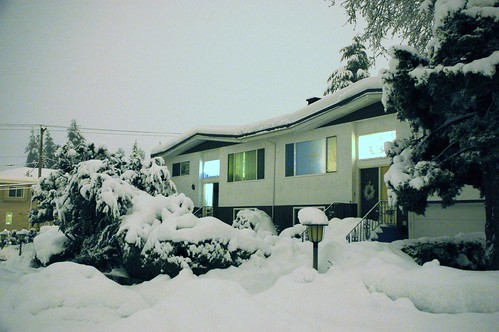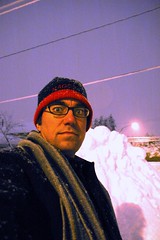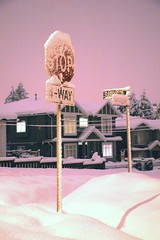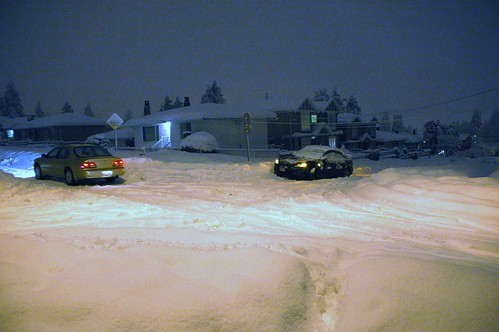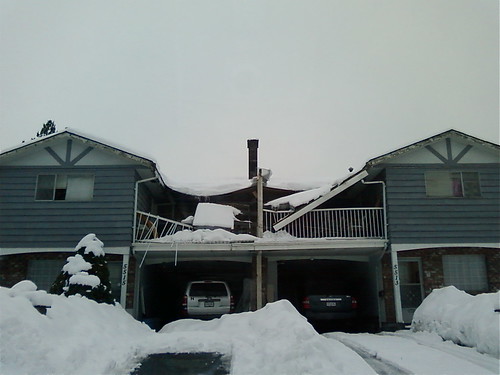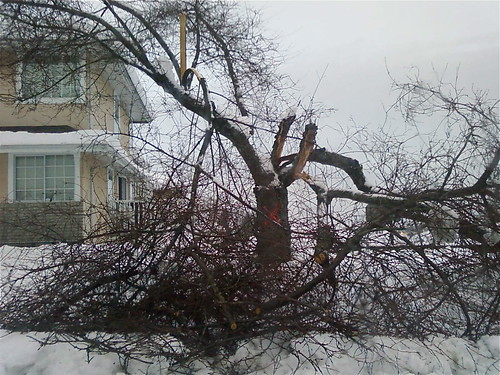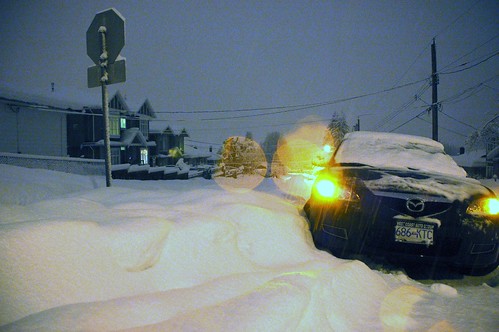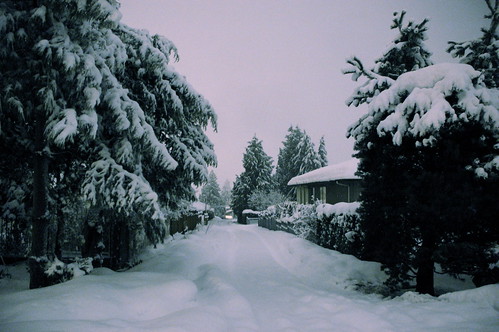Penmachine
29 April 2010
Ready to move
On Saturday, I'll be switching this blog from the Blogger publishing system, which I've used for almost ten years, over to Movable Type. I've been preparing for the move for a few weeks, and everything is pretty much ready.
What will change?
For you as a reader, not much:
- If you read my posts on my website at penmachine.com, you'll see a few minor alterations to the site layout, but overall things will be familiar. Similarly, if you read them as Notes on Facebook, everything will continue as normal.
- If you subscribe to my blog feed at penmachine.com/index.xml, some recent entries might appear twice, but new ones will only be there once, so it will soon settle back to normal. If you're using one of my older feed addresses (something like penmachine.com/rss.xml or penmachine.com/rss/rss.xml), things should redirect automatically. But if you don't see any updates in the first two days of May, then please re-subscribe using the proper address.
- My Penmachine Podcast feed remains at penmachine.com/podcast/index.xml. Nothing has changed there, and I haven't updated it since July 2009, so don't expect anything new for the moment.
- There will be a new subscription feed for comments on my blog, at penmachine.com/comments.xml, but as of today (April 29), that's not active yet.
Speaking of comments, perhaps the biggest change (which has happened already) is that you can no longer post new comments on any of my archived posts from October 2000 to April 2010, including this very entry. That's not the way I'd prefer it, but in starting fresh with Movable Type, it's just easier to lock down all the old stuff and move on.
You'll be able to post comments on new entries I publish from May 2010 onward. How you do that will look a little bit different than it used to, but will work essentially the same way as before, with a bit more flexibility for you.
Smooth, real smooth
I'm hoping that what is a fairly major technical transition for me is a smooth and barely noticeable change for you many kind folks who read this blog. What should matter to you (at least a little) is what I write, not how I publish it. There will likely be a few minor bumps and anomalies in the first week or so, but I hope to iron those out quickly.
Then I can get on with the next ten years of stuff.
Labels: blog, geekery, history, software, web, writing
09 April 2010
What does it mean to be old?
New Scientist has published a widely-linked article (via Kottke) this week called "The Shock of the Old," about how the world's population is aging. Author Fred Pearce is perhaps a bit too optimistic about what that means, but it's nevertheless a worthwhile read. It reinforces something I've written about before. As Pearce puts it:
We should be proud that for the first time most children reach adulthood and most adults grow old.
But old doesn't mean what it used to. I regularly hear news reports about an "elderly" person of age 70. But that's how old my parents are, and they don't seem at all elderly to me. Yes, my mom retired some years ago, but that doesn't seem to have slowed her down. My dad is still running his own business and driving to service calls almost every day. He'll happily climb a ladder to the roof of the house to clear out the gutters.
And of course, these days they're both in better shape than I am, at age 40.
I think societies like Canada's, where our population is aging rapidly, will have to adjust, to support people based not on the number of years they've lived, but on the capabilities they have. In some ways, we already do that—I'm receiving Canada Pension disability benefits, for instance. I don't know what that adjustment will look like, and I may not even live long enough to see the change, but it's coming.
Labels: age, canada, death, history, magazines, work
08 April 2010
Another relative
 It's quite astonishing how many fossils of extinct human relatives that paleontologists have found in recent years. Just in the past year, I've mentioned Darwinius and Ardipithecus. And this week we hear about Australopithecus sediba, which sheds further light on how ancient apes transitioned to walking upright like we do.
It's quite astonishing how many fossils of extinct human relatives that paleontologists have found in recent years. Just in the past year, I've mentioned Darwinius and Ardipithecus. And this week we hear about Australopithecus sediba, which sheds further light on how ancient apes transitioned to walking upright like we do.
It's a relief that in the latest coverage, the scientists involved have gone out of their way to say that A. sediba is not a "missing link":
"The 'missing link' made sense when we could take the earliest fossils and the latest ones and line them up in a row. It was easy back then," explained Smithsonian Institution paleontologist Richard Potts. But now researchers know there was great diversity of branches in the human family tree rather than a single smooth line.
All of evolution works that way: branching, somewhat messy relationships between organisms, with many extinct species and a few (or perhaps many) survivors. In the case of hominids, we humans are the only bipedal ones left, and we're also by far the most numerous of the surviving lineage, which includes chimpanzees, bonobos, gorillas, and orangutans too. So our evolutionary past can look linear, at least during the past 5 to 7 million years since our ancestral line diverged from the chimp ancestral line, even though it wasn't.
While we have found quite a few fossils of human relatives, that's a very relative term. Until the past few thousand years, there weren't many of us around at all. All the Australopithecus fossils ever found can be outnumbered by the number of trilobite fossils (which are hundreds of millions of years older!) in a single chunk of stone at any rocks-and-gems store. Hominid fossils are still extremely rare things, so we can't reconstruct the branches of our family tree with perfect accuracy. That's because we can't be sure which (if any) of the species we've unearthed were our direct ancestors, and which were our "cousins"—branches of the tree that died out.
Still, we can make attempts with the data we have, some making more assumptions than others, and the options being quite complex. Yet as we find out more, and discover more, our family tree becomes clearer. That's pretty cool.
Labels: africa, evolution, history, science
17 March 2010
The Nikon FM3A
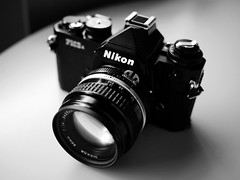 Camera nerds have strange obsessions. Among film cameras, the Leica M series of small rangefinder devices is probably top among photo fetishists, who might argue about whether the original 1950s M3 or the current M7 or MP is the optimum design.
Camera nerds have strange obsessions. Among film cameras, the Leica M series of small rangefinder devices is probably top among photo fetishists, who might argue about whether the original 1950s M3 or the current M7 or MP is the optimum design.
But to me, the manual-focus, precision-built electromechanical Nikon FM3A SLR is the real star of these old-school cameras. It was an oddity when Nikon introduced it in 2001—by which time ergonomically-shaped, plastic-bodied autofocus cameras were what almost everyone used, and digital was poised to take over from film almost entirely. (Even the FA of 1983, or the intro-level FG I owned around the same time, had more modern features in many respects.)
But Nikon was intentionally building a modernized retro camera for those fetishists. It offers basic but powerful light-metering, manual focus assistance, fill-flash compatibility, and aperture-priority automation if you want it. But it is also a fully-mechanical machine that will operate perfectly (except for the light meter) without any batteries. All the power to run it can come from energy stored in springs when you ratchet the film advance lever with your thumb, something that's hard to comprehend for anyone who's used to today's battery-sucking digital beasts, or even my 1988 autofocus Nikon F4.
Nikon only made the FM3A for five years, and manufactures nothing at all like it today. (Indeed, almost no one besides Leica makes fully mechanical cameras anymore.) If you can find one, it sells for pretty close to the $800 the model fetched when new, which is still a fraction the cost of a Leica or a top-of-the-line digital Nikon SLR. And it will use most Nikon-mount lenses made between 1977 and quite recently, when the company stopped including aperture rings on their SLR lenses.
I'd compare this rugged Nikon with modern versions of the Fender Stratocaster guitar, or a brand-new fountain pen: the FM3A looks superficially like something created decades earlier, and works pretty much that way too, but it has some clever modern enhancements that smooth the way for enthusiasts or professionals to use it elegantly. It's neat that Nikon ever decided to create it, and like the still-manufactured Nikon F6 film SLR, it's probably among the last of its kind.
Labels: film, geekery, history, nikon, photography
06 March 2010
Ida: now just a nice fossil
Remember the crazy hype last year about "Ida," the beautifully preserved 47 million–year–old primate? The one I called a "cool fossil that got turned into a publicity stunt?"
It turns out that, yes, the original authors seem to have rushed their paper about Ida into publication, presumably in order to meet a deadline for a TV special. And even by the loosest definition of the term, Ida is no "missing link" whatsoever, and not closely related to humans. (Not that relatedness to humans is what should make a fossil important, mind you.)
So now, like Ardi, who's ten times younger, Ida is what it deserves to be: a fascinating set of remains from which we can learn many things, but not anything that fundamentally revolutionizes our understanding of primate evolution. And that's a good thing.
Labels: africa, controversy, evolution, history, science, television
02 February 2010
So long, Blogger.com: I need a new blogging platform to publish static files
 For close to a decade, since October 2000, I've published this home page using Blogger, the online publishing platform now owned by Google. That entire time, I've used the original hacky kludge created by Blogger's founders back in 1999, where I write my posts at the blogger.com website, but it then sends the resulting text files over the Internet to a web server I rent, using the venerable FTP (File Transfer Protocol) standard—which was itself last formally updated in 1985. This is known as Blogger FTP publishing.
For close to a decade, since October 2000, I've published this home page using Blogger, the online publishing platform now owned by Google. That entire time, I've used the original hacky kludge created by Blogger's founders back in 1999, where I write my posts at the blogger.com website, but it then sends the resulting text files over the Internet to a web server I rent, using the venerable FTP (File Transfer Protocol) standard—which was itself last formally updated in 1985. This is known as Blogger FTP publishing.
While often unreliable for various technical reasons, Blogger FTP works effectively for me, with my 13 years of accumulated stuff on this website. But I am in a small, small minority of Blogger users (under 0.5%, says Google). Almost everyone now:
- Uses Blogger's own servers for their sites.
- Or another hosted service that takes care of everything for them.
- Or if they want to publish on their own servers, another tool like Movable Type, WordPress, or ExpressionEngine, which you install on your server and publish from there.
So, as I've been expecting for years, Blogger is now permanently turning off FTP publishing, as of late March 2010. And, in my particular case, that means I need to find a new blog publishing tool within the next month or so.
This has been coming for a long time
Blogger has all sorts of clever solutions and resources for people using FTP publishing who want to migrate to Google's more modern server infrastructure, but they don't fit for me. I have specific and very personal needs and weird proclivities about how I want to run this website, and putting my blog on Google's servers simply doesn't meet them.
That's sad, and a little frustrating, but I'm not angry about it—and I think it's misguided that many people commenting on this topic seem to be. I realize that I have been getting an amazing, easy publishing service for free for almost a quarter of my life from Blogger. It has enriched my interactions with thousands of people. Again, for free. (Actually, I did pay for Blogger Pro back in the day before the 2003 Google acquisition, but that was brief. And as thanks, Google sent me a free Blogger hoodie afterwards—I still wear that.)
The vast, vast, vast majority of users find the newer ways of publishing with Blogger meet their needs. And any of us who has used FTP publishing for years knows it's flaky and convoluted and something of a pain in the butt, and always has been since Ev and his team cobbled it together. I've been happily surprised that Blogger has supported it for so long—again, free.
Yes, it was a distinguishing feature of Blogger that you could use a fully hosted editing and publishing system to post to a web server where you don't have to install anything yourself. Very nice, but I think there are good technical reasons that no other service, free or paid—whether WordPress.com, TypePad, SquareSpace, or anything else—ever offered something similar.
I applaud the Blogger team for trying to do the best they can for us oddballs. And it serves as a reminder: Blogger FTP can go away. Gmail could go away. Facebook could go away. Flickr could go away. Twitter could go away. WordPress.com could go away. If you're building your life or business around free online tools, you need some sort of Plan B.
I've had this possibility on my mind at least since the Google takeover, seven years ago. Now I have to act on it. But I'm thankful for a decade of generally great and reliable free service from Blogger. I haven't had ten free years of anything like it from any other company (online or in the real world), as far as I know.
Getting nothing but static
One other thing I've always liked about Blogger's FTP publishing is that it creates static files: plain-text files (with file extensions like .html or .php or .css, or even no extensions at all). It generates those files from a database on Google's servers, but once they're published to my website, they're just text, which web browsers interpret as HTML (Hypertext Markup Language) to create the formatting and colours as such.
Most other blogging tools, including Blogger's hosted services, generate their web pages on the fly from a database. That's often more convenient for a whole bunch of reasons, and I'm happy to run other sites, such as Inside Home Recording and Lip Gloss and Laptops, with a database-dependent tool such as WordPress.
But this site is my personal one—the archive of most of my writing over the past 25% of my life. And I'm a writer and editor by trade. This website is my thing, and I've worked fairly hard to keep it alive and functional, without breaking incoming links from other sites, for well over a decade now. I've always wanted to keep it running with static files, which is one reason I didn't migrate from Blogger to WordPress four or five years ago. Over on Facebook, Gillian asked me why I'm so hardheaded about it. (She's a database administrator by trade.)
I'll be blunt about the most extreme case: I have cancer. I may not live that long. But I'd like my website to stay, even if only so my kids can look at it later. If necessary, if I'm dead, I want someone to be able to zip up the directory structure of my blog, move it to a new server, unzip it, and there it is, live on the Web. I don't want to have to plan for future database administration in my will.
In that worst case I won't need to update my site anymore, but I think static files on a generic web server are more reliable in the long run. To make a bulk change, a simple search-and-replace can update the text files, for example, to note that it's not worth emailing me, since, being dead, I'll be unable to answer.
On other blogging and content management systems I've worked with, I've had MySQL databases die or get corrupted. Restoring from MySQL backups is a pain for non-techies, or even for me. I've blown up a WordPress site by mis-editing one part of one file, and I've been able to fix it—but I don't want someone else to have to do that.
Right now, if Blogger died entirely, my site would still work exactly as-is. If my web host went belly-up, anyone with a teeny bit of web savvy and access to my passwords and one of my computers could redirect penmachine.com to a new server, upload the contents of one of my backup directories to it by FTP, and (other than visitors being able to post new comments) it would be up and live just like it was within a day or two.
In addition, tools like WordPress are brittle. I like using them, but there are security updates all the time, so the software goes out of date. That's fine if you're maintaining your site all the time, but if not, it becomes vulnerable to hacks. So if a database-driven site choogles on without updates, it's liable to get compromised, and be defaced or destroyed. That's less likely with a bunch of HTML files in directories—or at least I think so.
Betting on text
Plain text has been the language of computer interchange for decades. If the Web ever stops supporting plain text files containing HTML, we'll all have big problems. But I don't think that will happen. The first web page ever made still works, and I hope and expect it will continue to. My oldest pages here are mild derivatives from pages that are only five years younger than that one. They still work, and I hope and expect that they will continue to.
At worst, even a relatively non-technical person can take a directory dump backup of my current website and open the pages in a text editor. I can do that with files I've had since before the Web existed—I still have copies on my hard drive of nonsensical stories from BBSes I posted to in the '80s (here's an HTML conversion I made of one of them). I wrote those stories with my friends, some of whom are now dead, but I can still read what we wrote together.
Those old text files, copies of words I wrote before some of the readers of this blog were born, still work, and I hope and expect they will continue to. Yeah, maybe a SQL backup would be wise, but I'll still place my bets on plain text. Okay, I'm weird, but there you go.
Suggestions
Okay, so I need a new blogging platform. Probably one I can install on my server, but definitely one that generates static files that don't depend on a live database. Movable Type does that. ExpressionEngine might. More obscure options, like Bloxsom and nanoc, do so in slightly more obscure ways.
If you know of others I should look at, please email me or leave a comment. However long I'm around, I'll remain nostalgic about and thankful to Blogger. It's been a good run.
Labels: blog, death, geekery, history, linkbait, memories, software, web, writing
31 December 2009
I made it to another New Year
 Will I survive another decade? I'm only 40 now, but with all this cancer crap in my life since 2007, every New Year's Eve is a gift. And I have already outlived friends I didn't expect to.
Will I survive another decade? I'm only 40 now, but with all this cancer crap in my life since 2007, every New Year's Eve is a gift. And I have already outlived friends I didn't expect to.
Ten years ago, as 1999 ended, things were different for all of us. Yes, I was living in the same house with my wife and daughter, who was close to two years old—but we had another daughter due in a few weeks, whom we didn't know was a girl yet. I had kept the same stable job at a software company for over three years. The dot-com boom had not yet bust. I wouldn't end my five-year hiatus from my band for almost 11 months.
The big news in digital cameras was the Nikon D1, which had a 2.7 megapixel sensor and cost $5500 USD. At work, we had a Coolpix 950, which had similar resolution and took photos good enough to convince me that digital would eventually be the way to go for photography. Eventually.
But even ten years ago, we lived in a world without Mac OS X, iPods, and iPhones, with Napster but without an iTunes Store. "Wi-Fi" was a strange new word—those of us who networked our computers all used plugged-in wires, and I spent a good amount of time running Ethernet cables through our house for that purpose. Most of them are still there.
The term "hanging chad" had yet to be invented. As a society, we were worried less about international terrorism than about the Y2K bug. The World Trade Center towers in New York City still stood, bustling with people. You could take your own drinks aboard commercial airliners, not to mention more carry-on baggage than was strictly allowed. Cockpit doors were nearly always open to the cabin. Almost no one in the West had heard of Kandahar (in Afghanistan) or Banda Aceh (in Indonesia), substantial cities though they are.
The International Space Station was in early construction in orbit, very small compared to its current size. It was sometimes serviced by the space shuttle Columbia, which would only exist for another three years before breaking up on re-entry. Only a few extrasolar planets had been discovered. The Human Genome Project had not yet completed its sequencing.
People were wondering when James Cameron would make a follow-up movie to Titanic, since it had already been so long (two years). Guns 'n' Roses' new album Chinese Democracy was supposed to come out any old time. Justin Timberlake was still a member of N'Sync. The X-Files and Ally McBeal were still on the air; Survivor and CSI had yet to begin. Charles Schulz was still alive and drawing new "Peanuts" comic strips. The Concorde was still flying.
I'd already had and managed my diabetes for almost nine years. My varicose veins were under control. I thought that any form of cancer I might get would be many decades away. There were lots of things I didn't know. And lots I still don't.
I still have a wonderful family. My wife and I both made it past 40, and our kids are now almost 10 and 12. Our family now includes our first-ever puppy. Have a happy 2010. I hope to see you again for New Year's 2011. Fingers crossed.
Labels: family, geekery, history, memories, party
27 December 2009
Books old and new
When my mother was a little girl, she received a copy of the classic children's book Heidi, printed in 1945. This year, she dug that same copy out and gave it to my older daughter M as a Christmas present.
One gift I received this year from my friend Sebastien was an Amazon Kindle e-book reader. You can, of course, get Heidi for it. The two make an interesting contrast:
The chances that my Kindle will still be around and working in 65 years, to give away to a grandchild? Virtually zero, of course.
P.S. I should note that, as public domain works, Heidi and Johanna Spyri's other books are available for free online too. You can put them on your Kindle as plain text files that work just great, instead of spending the $3 for digitally-locked DRM versions.
Labels: books, family, geekery, history, holiday, memories
09 December 2009
The top riff
 British music site Musicradar recently published one of those visitor-voted lists of the 50 greatest guitar riffs (not solos, or rock songs) of all time. It's pretty much what you'd expect: heavy on the '70s, with plenty of Zeppelin, AC/DC, Metallica, Black Sabbath, and (being British) Radiohead, Muse, and such thrown in.
British music site Musicradar recently published one of those visitor-voted lists of the 50 greatest guitar riffs (not solos, or rock songs) of all time. It's pretty much what you'd expect: heavy on the '70s, with plenty of Zeppelin, AC/DC, Metallica, Black Sabbath, and (being British) Radiohead, Muse, and such thrown in.
But I have to say that the top 10 is an interesting result, climbing from "Satisfaction" (number 10?!) through "Day Tripper," "Enter Sandman," "Back in Black," "Layla," "Smoke on the Water" (number 4?!), and "Whole Lotta Love" to "Sweet Child o' Mine" at number 2. Not a surprising list of candidates, though I wouldn't have predicted that order.
Number one, though, I would never have forecast in the top 10, never mind at the peak, even though I personally agree it's the right choice: Jimi Hendrix's "Voodoo Child (Slight Return)," from 1968. Here, watch the full psychedelicness:
Hendrix and his band basically jammed the song out in the studio while creating footage for a visiting film crew. The song as a piece is like a whole weather system, and it's hard to know exactly what Musicradar's users were voting for—is it Jimi's slinky, ominous solo wah-wah raindrops at the beginning, or the full booming open-string thunderstorm once the full band comes in?
It doesn't really matter. I think either one wins. Stevie Ray Vaughan, my favourite guitarist, used to play "Voodoo Child (Slight Return)" all the time, but even the best he could do was basically replicate Jimi nearly note-for-note.
Many music fans might know the song, but the riff certainly isn't among those people hum to themselves, like "Killing in the Name," "Sunshine of Your Love" or "Ticket to Ride." Certainly no beginning guitarist would attempt it, as they would "Satisfaction" or "Smoke on the Water" or "You Really Got Me," which is on the Musicradar list, but shamefully not in the top 10. I can't play a lick of it.
Yet "Voodoo Child" stands apart. (Joe Satriani called it "the greatest piece of electric guitar work ever recorded.") That main thundering riff is both separate from and weaved throughout the song—you never know when Jimi will drag it back out from the maelstrom. It's scary and beautiful and bluesy and futuristic—like Jimi himself in a few notes.
I think I'll go listen to it again.
P.S. Of course I have quibbles with the list too. Three riffs mysteriously missing are the Violent Femmes' "Blister in the Sun," Van Morrison's "Brown Eyed Girl," and of course Lynyrd Skynyrd's "Sweet Home Alabama." How did people miss that one?
Labels: controversy, guitar, history, linkbait, lists, music
11 November 2009
Death and idealism
I have heard there was a time when some of the older veterans at today's Remembrance Day ceremonies thought there might be no more wars. They fought, and died, and killed, and saw the waste and destruction—and believed that perhaps the cost was too great. That nations and societies could decide to put the barbarism behind us.
There were young veterans at the ceremonies today, much younger than me, returned from Afghanistan and elsewhere. Sadly, I don't think they can share in that old idealism.
Labels: death, history, holiday, remembranceday, war
07 November 2009
The end of the Wall
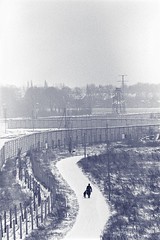 When I saw the footage of people hammering away at the Berlin Wall 20 years ago, I cried. I've never been there (the closest I came was Frankfurt Airport, three years earlier), but it's where my dad was born in 1939. Berlin has always loomed large in my family's history—through stories from him and my aunt, from my grandmother and step-grandfather, of the War, and the Blockade. And in the phone calls and letters to and from the city, where we still have relatives.
When I saw the footage of people hammering away at the Berlin Wall 20 years ago, I cried. I've never been there (the closest I came was Frankfurt Airport, three years earlier), but it's where my dad was born in 1939. Berlin has always loomed large in my family's history—through stories from him and my aunt, from my grandmother and step-grandfather, of the War, and the Blockade. And in the phone calls and letters to and from the city, where we still have relatives.
Berlin is where my grandfather Karl, my father's father, died in 1947. Thin and weakened in a Russian PoW camp, he returned to his family when the War ended, but never regained his full health. In the ravaged city, medical care wasn't quite good enough, or medicine available enough, to save him when he caught an infection—perhaps pleurisy, perhaps something else. With modern antibiotics and intensive care, he would probably have lived. And I would almost certainly never have been born.
My parents will be in Berlin again this week, able to cross back and forth across the city. The Wall is only shards now, the city and Germany itself now whole, if sometimes awkwardly. I visited Moscow and what was then Leningrad in 1985, while Russia was still fully Communist, though waning. Where today there are billboards, then the signs were only massive revolutionary slogans. To my children, the Cold War is history, long gone before they were born.
But it's not really gone. Current events emerge from what happened then. And my father told me that, a few years ago when he visited the village in the former East Germany to which he'd been evacuated late in the War, the buildings still had bullet holes in the walls.
Labels: anniversary, europe, family, history, war
06 November 2009
Raising free-thinking kids
(Cross-posted from Buzz Bishop's DadCAMP.)
Back in the mid-1970s when I grew up in Vancouver, almost all the stores were closed on Sundays, because of a piece of legislation called the Lord's Day Act. Every day before class in elementary school, we said the Lord's Prayer. These were vestiges of a general assumption, made since British Columbia was colonized a century earlier: even if everyone in B.C. wasn't Christian, the province would still run as if they were.
But Metro Vancouver has become remarkably secular in the three decades since then. In the 2001 Census, 40% of the population identified itself as having "no religious affiliation," and the proportion is probably even bigger now. (That's two and a half times the average across Canada.) My wife and I fit the trend: we have raised our two daughters, ages 9 and 11, in a non-religious household. Like us, few of our friends attend a mosque, temple, or church.
Buzz asked me to write this post because he saw that I just joined the Facebook group for Parenting Beyond Belief, a website run by Dale McGowan from Atlanta, Georgia. I signed up not because I needed much advice about raising children without religion (something many of us now do, especially in Vancouver), but to note publicly that it's been the approach in my family since our kids were born.
[Read more at dad-camp.com...]
Labels: canada, family, history, religion, vancouver, web
02 November 2009
Listen to the Salish Sea
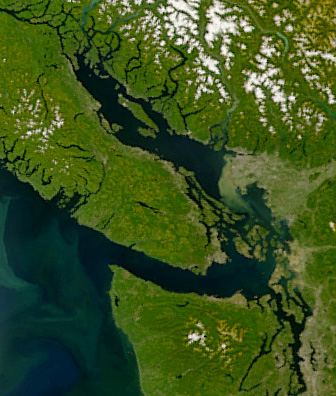 When I interviewed CBC Radio producer Paolo Pietropaolo back in January on the Inside Home Recording podcast, he talked about his upcoming documentary on the Salish Sea here in British Columbia.
When I interviewed CBC Radio producer Paolo Pietropaolo back in January on the Inside Home Recording podcast, he talked about his upcoming documentary on the Salish Sea here in British Columbia.
The original version appeared in the spring, and a documentary edition was broadcast this morning on the Canada-wide radio show "The Current." You can listen to both. They might work best in headphones, even though they weren't broadcast in stereo.
Labels: canada, cbc, environment, history, oceans, radio, seattle, vancouver
13 October 2009
Growth of the City of Glass
Dave Winer has posted a bunch of photos from his parents, reaching back more than 50 years. A picture of Vancouver's Coal Harbour from his family trip here in the '60s is fascinating, because here's a similar view today.
Things have changed a little. If you open the two images in separate windows or browser tabs and look carefully, you might be able to spot a couple of the same buildings.
Labels: davewiner, history, photography, vancouver
11 October 2009
The slow history of Vancouver
Vancouver historian Chuck Davis has been writing a series of posts for re:place magazine about the city, summarizing a single year of the city's history each time. The series is called "A Year in Five Minutes," though I think you'd have to read pretty fast to get through each entry in that little time.
He's just reached 1938 and 1939, the years my mother (here in Vancouver) and father (in Berlin) were born, respectively. You can visit the Year in Five Minutes category regularly, or subscribe to the RSS feed for those stories. I'm finding them an enjoyable read. Fellow Vancouverites, former residents, or other B.C. history buffs might too.
Labels: blog, history, vancouver, web
02 October 2009
Ardi is another fascinating hominid fossil, but "missing link" no longer makes sense
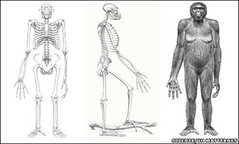 First, let's get something out of the way: the term missing link has long been useless, especially in human palaeontology. That's reinforced by this week's publication of a special issue of the journal Science, focusing on the 4.4-million-year-old skeleton of Ardipithecus ramidus, nicknamed "Ardi."
First, let's get something out of the way: the term missing link has long been useless, especially in human palaeontology. That's reinforced by this week's publication of a special issue of the journal Science, focusing on the 4.4-million-year-old skeleton of Ardipithecus ramidus, nicknamed "Ardi."
Chimpanzees are the closest living relative to human beings in the world, but our common ancestor lived a long time ago—at least 6 million years, likely more. When Charles Darwin proposed, some 150 years ago, that the fossil links between humans and chimps were likely to be found in Africa, he was right, but at the time those links really were missing.
It took a few decades until the first Homo erectus fossils were found in Asia. Since then, palaeontologists have found many different skeletons and skeletal parts of Homo, Paranthropus, and Australopithecus, with the oldest, as predicted, all in Africa. We've been filling in our side of the chimp-human family tree for over a century. (The chimpanzee lineage has been more difficult, probably because their ancestors' forest habitats are less prone to preserving fossils—and we're less prone to paying as much attention to it too.)
So it's been a long time since the links were missing, and the term missing link is now more misleading than helpful. Like "Ida," the 47-million-year-old primate revealed with too much hype earlier this year, "Ardi" is no missing link, but she is another fascinating fossil showing interesting things about our ancestry. Most notably, she walked upright as we do, but had a much smaller brain, more like other apes—as well as feet that remained better for climbing trees than ours.
None of that should be shocking. We shouldn't expect any common ancestor of chimps and humans to be more like either one of us, since both lineages have kept evolving these past 6 million years. Ardi isn't a common ancestor—she's more closely related to humans than to chimps, and accordingly shows more human characteristics (or, perhaps better, we show characteristics more like hers), like bipedal walking and flexible wrists. That's extremely cool.
Also interestingly, "Ardi" is not new. It's taken researchers more than 15 years to analyze her, and similar fossils found nearby in Ethiopa's Afar desert. Simply teasing the extremely fragile, powdery fossil materials out of the soil without destroying them took years. Science can sometimes be a painstaking process, not for those who lack patience.
Labels: africa, controversy, evolution, history, science
14 September 2009
Book Review: Say Everything
 It's a bit weird reading Say Everything, Scott Rosenberg's book about the history of blogging. I've read lots of tech books, but this one involves many people I know, directly or indirectly, and an industry I've been part of since its relatively early days. I've corresponded with many of the book's characters, linked back and forth with them, even met a few in person from time to time. And I directly experienced and participated in many of the changes Rosenberg writes about.
It's a bit weird reading Say Everything, Scott Rosenberg's book about the history of blogging. I've read lots of tech books, but this one involves many people I know, directly or indirectly, and an industry I've been part of since its relatively early days. I've corresponded with many of the book's characters, linked back and forth with them, even met a few in person from time to time. And I directly experienced and participated in many of the changes Rosenberg writes about.
The history the book tells, mostly in the first couple of hundred pages, feels right. He doesn't try to find The First Blogger, but he outlines how the threads came together to create the first blogs, and where things went after that. Then Rosenberg turns to analysis and commentary, which is also good. I never found myself thinking, Hey, that's not right! or You forgot the most important part!—and according to Rosenberg, that was the feeling about mainstream reporting that got people like Dave Winer blogging to begin with.
Rosenberg's last book came out only last year, in 2008, so much of what's in Say Everything is remarkably current. He covers why blogging is likely to survive newer phenomena like Facebook and Twitter. And he doesn't hold back in his scorn for the largely old-fashioned thinking of his former newspaper colleagues (he used to work at the San Francisco Examiner before helping found Salon).
But then I hit page 317, where he writes:
...bloggers attend to philosophical discourse as well as pop-cultural ephemera; they document private traumas as well as public controversies. They have sought faith and spurned it, chronicled awful illnesses and mourned unimaginable losses. [My emphasis - D.]
That caused a bit of a pang. After all, that's what I've been doing here for the past few years. It hit close to home. Next, page 357:
For some wide population of bloggers, there is ample reason to keep writing about a troubled marriage or a cancer diagnosis or a death in the family, regardless of how many ethical dilemmas must be traversed, or how trivial or amateurish their labours are judged. [Again, my emphasis - D.]
Okay, sure, there are lots of cancer bloggers out there. I'm just projecting my own experience onto Rosenberg's writing, right? Except, several hundred pages earlier, Rosenberg had written about an infamous blogger dustup between Jason Calacanis and Dave Winer at the Gnomedex 2007 conference in Seattle.
The same conference where, via video link, I gave a presentation, about which Rosenberg wrote on his blog:
Derek K. Miller is a longtime Canadian blogger [who'd] been slated to give a talk at Gnomedex, but he’s still recovering from an operation, so making the trip to Seattle wasn’t in the cards. Instead, he spoke to the conference from his bed via a video link, and talked about what it’s been like to tell the story of his cancer experience in public and in real time. Despite the usual video-conferencing hiccups (a few stuttering images and such), it was an electrifying talk.
Later that month, he mentioned me in an article in the U.K.'s Guardian newspaper. When he refers to people blogging about a cancer diagnosis, he doesn't just mean people like me, he means me. Thus I don't think I can be objective about this book. I think it's a good one. I think it tells an honest and comprehensive story about where blogging came from and why it's important. Yet I'm too close to the story—even if not by name, I'm in the story—to evaluate it dispassionately.
Then again, as Rosenberg writes, one of blogging's strengths is in not being objective. In declaring your interests and conflicts and forging ahead with your opinion and analysis anyway, and interacting online with other people who have other opinions.
So, then: Say Everything is a good book. You should read it—after all, not only does it talk about a lot of people I know, I'm in it too!
Labels: blog, books, cancer, gnomedex, history, review, web
06 September 2009
Les Paul's legacy
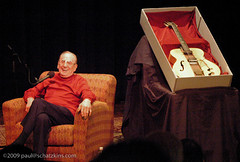 A few weeks ago I wrote about Les Paul, who died in mid-August at the age of 94. My podcast co-host Dave Chick and I decided that our next episode of Inside Home Recording would be a Les Paul special edition, dedicated to different aspects of Les's career, because as the inventor of multitracking and pioneer of solidbody electric guitars, he was so important to modern recording.
A few weeks ago I wrote about Les Paul, who died in mid-August at the age of 94. My podcast co-host Dave Chick and I decided that our next episode of Inside Home Recording would be a Les Paul special edition, dedicated to different aspects of Les's career, because as the inventor of multitracking and pioneer of solidbody electric guitars, he was so important to modern recording.
Tonight, we put that tribute episode (IHR #74, available as an enhanced AAC or audio-only MP3 podcast) online. In the process of putting it together, both Dave and I were astonished by how much Les Paul accomplished that we didn't even know about—most of it before we or any of our listeners were born.
I came to the conclusion, expressed in the our editorial at the end of the show, that Les was the single most important person in the history of modern recorded music—more important, on balance, than Thomas Edison or Leo Fender or Elvis or the Beatles or any of the other contenders.
You can listen to the show to find out if you agree. But it's indisputable that anywhere in the world where there is a microphone or a speaker, a Record button or a set of headphones—from every music studio or TV soundstage to every car stereo or iPod earbud, from every crummy punk dive bar to every high-end hip-hop nightclub, from the Amundsen-Scott outpost at the South Pole to the International Space Station—Les Paul played a part in making them what they are.
Labels: death, guitar, history, insidehomerecording, jazz, music, recording
21 August 2009
Gnomedex 2009 day 1
 My wife Air live blogged the first day's talks here at the 9th annual Gnomedex conference, and you can also watch the live video stream on the website. I posted a bunch of photos. Here are my written impressions.
My wife Air live blogged the first day's talks here at the 9th annual Gnomedex conference, and you can also watch the live video stream on the website. I posted a bunch of photos. Here are my written impressions.
Something feels a little looser, and perhaps a bit more relaxed, about this year's meeting. There's a big turnover in attendees: more new people than usual, more women, and a lot more locals from the Seattle area. More Windows laptops than before, interestingly, and more Nikon cameras with fewer Canons. A sign of tech gadget trends generally? I'm not sure.
As always, the individual presentations roamed all over the map, and some were better than others. For example, Bad Astronomer Dr. Phil Plait's talk about skepticism was fun, but also not anything new for those of us who read his blog. However, it was also great as a perfect precursor to Christine Peterson, who invented the term open source some years ago, but is now focused on life extension, i.e. using various dietary, technological, and other methods to improve health and significantly extend the human lifespan.
- Some stuff Dr. Plait said: "Skepticism is not cynicism." "You ask for the evidence [...] and make sure it's good." "Be willing to drop an idea if it's wrong. Yeah, that's tough." "Scientists screw it up as well." "It sucks to be fooled. You can lose your money. You can lose your life."
- Christine Peterson: "Moving is how you tell your body, I'm not dead yet!" "You see people hitting soccer balls with their heads. Would you do that with your laptop? And that's backed up!" (You might like my friend Bill's reaction on my Facebook page.)
As Lee LeFever quipped on Twitter, "The life extension talk is a great followup to the skepticism talk because it provides so many ideas of which to be skeptical." My thought was, her talk seemed like hard reductionist nerdery focused somewhere it may not apply very well. My perspective may be different because I have cancer; for me, life extension is just living, you know? But I also feel that not everything is an engineering problem.
There were a number of those dichotomies through the day. Some other notes I took today:
- Bre Pettis passed out 3D models "printouts" created with the MakerBot he helped design. "Bonus points for being able to print out your... uh... body... parts." "Oh my god, you should put this brain inside Walt Disney's head!" "What's black ABS plastic good for?" "Printing evil stuff."
- One of the most joyous things you'll ever see is a keen scientist really going off on his or her topic of specialty. Firas Khatib on FoldIt protein folding was one of those. For a given sequence of amino acids, the 3D protein structure with lowest free energy is likely to be its useful shape in biology—and his team made a video game to help people figure out optimum shapes, which in the long run can help cure diseases.
- Todd Friesen is a former search engine and website spammer. He had lots of interesting things today. In the world of white and black search engine optimization (SEO), SPAM = "Sites Positioned Above Mine." For spammers, RSS = "Really Simple Stealing" and thus spam blogs. Major techniques for web spammers: hacking pages, bribing people for access, forum posts and user profiles, comment spam. Pay Per Click = PPC = "Pills, Porn, and Casinos."
- I liked these from the Ignite super-fast presentations: "There are more social media non-gurus than social media gurus. Which means we can take them." On annual reports: "Imagine waiting A YEAR to find out what a company is doing."
We had a great trip down to Seattle via Chuckanut Drive with kk+ and Fierce Kitty. Tonight Air and I are sleeping in the Edgewater Hotel on Seattle's Pier 67, next to the conference venue, and tonight is also the 45th anniversary of the day the Beatles stayed in this same hotel and fished out the window.
Labels: anniversary, band, biology, conferences, geekery, gnomedex, history, music, science, travel
27 July 2009
Booze, smokes, girls, advertising
Here's what I'd look like if I were on the TV show Mad Men, set at the turn of the smokin', drinkin', womanizin' 1960s of Manhattan advertising men:
Image made using the Mad Men Yourself tool (via Kottke). My wife and I are making our way through the Season 2 DVDs right now, and I feel like I'm getting second-hand smoke through the television.
Labels: americas, cartoon, history, television, web
18 May 2009
Boom
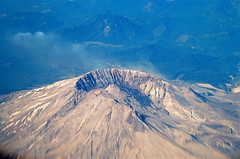 On the morning of May 18, 1980, exactly 29 years ago, I was camping with my Boy Scout troop at Furry Creek, north of Vancouver on the shore of Howe Sound. (The location is now part of a large golf course development, but at the time was essentially just forest near the highway.)
On the morning of May 18, 1980, exactly 29 years ago, I was camping with my Boy Scout troop at Furry Creek, north of Vancouver on the shore of Howe Sound. (The location is now part of a large golf course development, but at the time was essentially just forest near the highway.)
We awoke, terrified, to an enormous thundering crash. It was not, as we had thought, a train derailment on the railroad right near our campsite. It was the titanic sound of the eruption of Mount St. Helens—a sound which had arrived after traveling about 300 km northwest from the explosion. Back in Vancouver, my dad thought our water heater had exploded in the basement.
It was a good reminder that we live in a zone of earthquakes and volcanoes.
Labels: americas, anniversary, history, volcanoes
17 May 2009
Black Destroyer
Enthusiasts agree that science fiction's Golden Age began with A.E. van Vogt's short story "Black Destroyer," published in July 1939, two months after my father was born. You can read the story online, and you'll recognize a lot in it.
So many SF stories have followed in its tradition, but few have done the most interesting thing van Vogt tried: he got inside the head of the lone alien monster, and told most of the tale from its point of view. The atomic power in the story seems a bit hackneyed now—but recall, it was 1939, six years before the Manhattan Project.
Van Vogt, a Canadian, lived a long time, and he saw real voyages through the solar system. He died on January 26, 2000, coincidentally the same day my younger daughter was born. And "Black Destroyer" is still one of the coolest SF short story titles I can think of.
Labels: geekery, history, science, writing
13 May 2009
B.C. voters prefer the lame status quo
The BC Liberals won the British Columbia election again last night, as I expected. B.C. citizens gave them basically the same proportion of the vote and a slightly larger percentage of seats in the Legislature. Much more depressingly, voter turnout was yet again lower and BC-STV was resoundingly defeated. That's over. We're back with what we had before.
The BC Liberals are not my preferred choice, but they are at least tolerably competent in many respects. I guess I can live with that. However, the STV referendum gave us the chance to make our provincial government more representative and more interesting in the future, and we British Columbians turned it down.
My gut reaction is that yesterday, we B.C. voters were, on balance, lazy and chickenshit. That half of eligible voters didn't even bother, and that of those who did, a significant majority thought our current skewed system is just fine—well, that chafes.
I don't know if the numbers bear it out, but to me it feels like more people cared about how the Canucks did in the hockey playoffs than about deciding on the people we pay to respond to climate change, or to combat poverty, or to run the bloody province. And that we'll will bitch and complain about roads or homelessness or white-elephant megaprojects or the Olympics or cronyism and then not even vote when we get the chance.
On the bright side, perhaps the Liberals will be emboldened by a third straight victory to go beyond baby steps in their environmental policy. Maybe they can take a real lead in Canada on that most important of issues. They have a mandate to. I'm not optimistic, but I hope they run with it.
Labels: canada, environment, history, politics
12 May 2009
Today's vote
We're having a provincial election in British Columbia today, to decide which of our political parties will form the government for the next few years here on Canada's west coast. As in the British and Canadian federal parliamentary systems, we elect a local Member of the Legislative Assembly (MLA), and whichever party elects the most runs the province.
Tim Bray summarizes the situation much the way I would—however, despite my distaste for the social democrat NDP's pandering on environmental policy, I'm still voting for them, rather than for the Greens as Tim is.
That's a strategic choice. Like him, I think the referendum on electoral reform we're also holding today is even more important: the BC-STV (Single Transferable Vote) proposal is, I think, a good one, and would allow a vote for the Green Party (or other less mainstream parties and candidates) to mean something in subsequent elections. I hope it passes, as it nearly did in 2005. If it fails, I think any idea of electoral system reform in Canada will be dead for a long, long time, which would be a shame.
My wife and I voted about half an hour ago, and foot traffic at our local poll was brisk, but there were no lineups. Unlike in the United States, we continue to use simple paper ballots, marked with pencils, for all our elections here in Canada, and the results always come in quickly and efficiently. While counting might take a tad longer, that will still be true next election if BC-STV passes, despite the "it's too complicated" tactics of the No To STV campaign. As for today's vote, we'll know by late this evening what the results are.
If you're a B.C. citizen of eligible age, please make sure you vote today—you have a little over five hours until the 8 p.m. closing time at the polls. (Bring your yellow voter card and a piece of ID with your address, like a driver's license.) Even if you don't know or care enough about the parties or candidates to elect an MLA, if you support BC-STV, then please go out and vote just for that. It's important.
Labels: canada, history, politics
02 May 2009
Knowing the reactor
 It's been just over 30 years since the Three Mile Island nuclear power plant had a partial meltdown. In many ways, Three Mile Island marked the end of the age of innocence for nuclear power, with the door slammed seven years later by Chernobyl.
It's been just over 30 years since the Three Mile Island nuclear power plant had a partial meltdown. In many ways, Three Mile Island marked the end of the age of innocence for nuclear power, with the door slammed seven years later by Chernobyl.
I was nine, but tech columnist Bob Cringely was there. He says the accident happened because:
[The operators' job] was to follow the manual. All knowledge was inside the book. So knowing the book was everything. Unfortunately knowing the book isn’t the same as knowing the reactor.
How many of us, in the things we do, know the book but don't know the reactor? We know the processes, or the steps, but not the reasons behind them. But knowing how and why something works lets you handle the unexpected.
Labels: controversy, history, science
06 March 2009
Links of interest (2009-03-06):
- Transom.org has some wonderfully comprehensive audio articles for podcasters, like the stand mic shootout, handheld mic shootout, and recording phone calls tutorial (via Doug Kaye).
- PhotoFunia lets you put your own face into various stock photos (via J-Walk). Some work better than others. A couple of sample pictures of one of my daughters and me:


- Mac OS iPhone project (via Melanie). It was bound to happen.
- Photographic shit disturber Ken Rockwell points to these two great posts about film photography from John Sevigny, on the theme of digital cameras: the thrill is gone: "Many of the film oriented products introduced at PMA [this week's big photo tradeshow] are far more interesting than anything digital that bothered to show up to the party. [...] My advice: get [a used Nikon] FM2 for less than $500, three or four lenses for another $500 total, and a 35mm film scanner for another $500. [...] Use the remaining $6,500 to fly to Brazil, China, Mexico or Thailand and spend several months photographing there."
- Isabella and Raul have started organizing Mental Health Camp, an unconference here in Vancouver about mental health issues, April 25, 2009 in Gastown. (UPDATE: It now has its own URL at MentalHealthCamp.org.)
- Remember that crazy Leica R9 SLR camera I blogged about in 2007? Well, Leica long ago stopped making the digital back, and now they're discontinuing the camera and lenses too. But not to worry: an all-digital, autofocus R10 will come eventually. And will be amazingly high-priced, just like its upcoming big sibling the S2.
- Rebecca posts about Rudyard Kipling's visits to Vancouver in the 1800s and early 1900s, and how much our city changed during that time.
- The Onion's "San Francisco Historians Condemn 1906 Earthquake Deniers" is almost as good as the old "Evangelical Scientists Refute Gravity With New 'Intelligent Falling' Theory."
Labels: controversy, film, geekery, history, linksofinterest, mentalhealth, photography, podcast, recording, science, vancouver
02 March 2009
End of an era
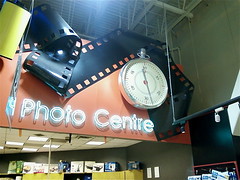 Today I brought some rolls of black-and-white film photos, which I'd taken at Northern Voice and our vacation last week, to the Save-On-Foods one-hour photo lab at Metrotown in Burnaby. Since the film was not regular silver halide B&W, but the kind that can be processed in a colour print minilab, Save-On developed, printed, and scanned the pictures in an hour.
Today I brought some rolls of black-and-white film photos, which I'd taken at Northern Voice and our vacation last week, to the Save-On-Foods one-hour photo lab at Metrotown in Burnaby. Since the film was not regular silver halide B&W, but the kind that can be processed in a colour print minilab, Save-On developed, printed, and scanned the pictures in an hour.
But at the end of the week, Save-On is shutting down its one-hour lab. That's the end of an era for me—I've been having film developed, as well as both film and digital pictures printed there, for about 20 years. It's a sign. Hardly anyone but photo enthusiasts uses film anymore. Since I started shooting film again last summer, I've hardly ever seen anyone else bringing film into the Save-On lab. Usually the attendant is reading a book.
There are plenty of other options nearby, including the inexpensive Costco one-hour lab down the hill, the nearby London Drugs, and maybe one or two in the mall. There are also numerous proper pro labs in the city that will process and print nearly any kind of film with loving care—and for a price. But I'll miss the corner of Save-On with its now-outdated big-ass sign featuring a giant model film roll and 60-minute stopwatch.
Labels: film, geekery, history, photography, vancouver
05 February 2009
The big gap
 For the past couple of weeks I've been reading God's Crucible
For the past couple of weeks I've been reading God's Crucible, a history book by David Levering Lewis—which I gave to my dad for Christmas, but which he's loaned back to me. Today I got a lot of reading done, because my body was screwing with me: I'll have to skip my cancer medications for the next day or two because the intestinal side effects, unusually, lasted all day today and into the night, and I have to give my digestive system (and my butt) a rest.
Lewis's book covers, at its core, a 650-year span from the 500s to the 1200s, during which Islam began, and rapidly spread the influence of its caliphate from Arabia across a big swath of Eurasia and northern Africa, while what had been the Roman Empire simultaneously fragmented into its Middle Ages in Europe. That's a time I've known little about until now.
The history I took in school and at university covered lots of things, from ancient Egypt and Babylon up to the Roman Empire, and from the Renaissance to the 20th century, as well as medieval England. I learned something about the history of China and India, as well as about the pre-Columbian Americas. But pre-Renaissance Europe and the simultaneous rapid expansion of the dar al-Islam are a particularly big gap for me.
Whose Dark Ages?
I knew a little about Moorish Spain, and a tad about Charlemagne and Constantinople, but otherwise it was just the Dark Ages for me, and for a lot of students who learned the typical Eurocentric view of history. There was much more going on in more populated and interesting parts of the world, though. While Europeans (not even yet named that) eked along with essentially no currency, trade, or much cultural exchange beyond warfare with horses, swords, and arrows:
- China went through the Sui, Tang, and Song dynasties, reaching the peak of classical Chinese art, culture, and technology.
- India also saw several dynasties and empires, as well as its own Muslim sultans.
- Large kingdoms of the Sahel in near-equatorial Africa arose, including those of Ghana, Takrur, Malinke, and Songhai.
- The Maya in Central America developed city-states and the only detailed written language in the Western Hemisphere.
- The seafaring Polynesians reached their most distant Pacific outposts, including Easter Island, Hawaii, and New Zealand.
Crucially important, of course, was Islam. Muhammad was born in the year 570, and shortly after he died about six decades later, Muslim armies exploded out of Arabia and conquered much of the Middle East and North Africa, then expanded east and north into Central Asia. By the early 700s, the influence of the caliphate headquartered in Damascus had reached Spain (al-Andalus), where Muslims would remain in power for 700 years.
In his book, Lewis flies through the origins of Islam, the foundations of the Byzantine and Roman branches of the Catholic Church after the fall of Rome, the interminable conflict between it and Zoroastrian Persia to the east, the Muslim caliphate's sudden rise up the middle to take over the eastern and southern Mediterranean, and the crossing of Islamic armies into Europe at Jebel Tariq (now called Gibraltar) in 711. Then things bog down a little.
I'm about half-way through the book, and Lewis throws out so many names, alternate names for the same people, events, places, and such that it's hard to keep up. He hops back and forth in time enough that what story he's trying to tell isn't always clear—he was won the Pulitzer Prize, but that was for more focused historical biographies, such as of W.E.B. Du Bois, rather than sweeping surveys like this one. His writing isn't overly complex, and I'm learning a lot, but it's a tough go sometimes. Still, I think it will be worth sticking it out.
Labels: books, europe, history, religion, review
04 January 2009
Vancouver's blizzards have rendered my neighbourhood snowbound
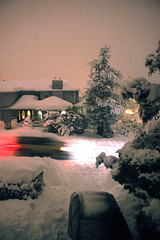 I've lived in this small section of town, near Metrotown in Burnaby, B.C., for the last 37 years, since I was two years old. I've never seen snow accumulations like this, not even in the record-setting 1996-97 season. Maybe it was like this in 1964, or in the early '70s when I was young, but I don't recall it.
I've lived in this small section of town, near Metrotown in Burnaby, B.C., for the last 37 years, since I was two years old. I've never seen snow accumulations like this, not even in the record-setting 1996-97 season. Maybe it was like this in 1964, or in the early '70s when I was young, but I don't recall it.
The shovel pile on the left side of the bottom of our driveway is nearly as tall as me. I minimally dug out the driveway before going for groceries at 7 p.m. today. I got back at 8 p.m. and could not drive up, even in snow tires, so I shoveled again, because 3 or 4 cm had accumulated. I managed to finesse the car in.
Trees are coated. Houses look like marshmallow sundaes. Power and telephone lines are unpredictably dropping thick ropes of snow to the ground, then swaying from the release.
This is after regular snowfall since mid-December, little of which has melted. Around here (some altitude above sea level), we had very low temperatures (–15°C) in early December, then snow in the middle of the month, continued cold, more snow before Christmas, a bit of melt after, then a freeze, then more snow, and more, and more.
Up the street where people have bigger driveways, the snow piles are considerably taller than me. Street signs are becoming obscured, and sidewalks have disappeared—people must walk in the wheel ruts on the street:
Since Greater Vancouver has little history of lasting snow, most people around here don't have proper snow tires, which makes it worse for driving. My wife and I do have them on one of our cars, but even with those I had trouble on the steep driveway this evening.
Some people have abandoned their cars tonight in our neighbourhood. Others are putting on tire chains even on major bus routes that have been plowed. Still other vehicles have been so buried since before Christmas that you can't see them at all, just big lumps in the snow. People with 4WD but not snow tires are getting stuck now.
Today's bout is taking things over the edge. Forecasts have called for rain several times in the past week, and in some parts of Vancouver it came, but here it has been snow every time. The roof added above a sundeck on a house a few blocks away collapsed, and our neighbours lost a large cherry blossom tree after Christmas for the same reason:
Tonight the whole region is in a blizzard, and police are recommending no one drive unless they really have to—and then chains or snow tires are necessary.
Some of the streets are getting hemmed in from shoveling, buried cars, and the occasional plow heaping stuff up, plus the ruts are getting so deep that the snow in the middle is scraping the bottom of our car when we drive there:
I should say that the City of Burnaby crews do plow side streets when the clearing of major roads is sufficient and time permits. One of the streets on our corner was plowed several times in December; the less-used street out front, once.
But neither has been done in some time since the snow kept coming up here on the north brow of the hill. The trucks need to keep the highways and main streets open. It's beautiful, but pretty soon walking (or snowmobiles, or dogsleds) will be the only option on our street.
I never thought I'd say this in winter in this city, but I sure hope for rain, and lots of it. Not all at once, mind you—for a gradual melt, a nice steady drizzle for a week or two would do. You know, normal Vancouver weather?
Labels: history, memories, snow, vancouver, weather
05 December 2008
History of the mall
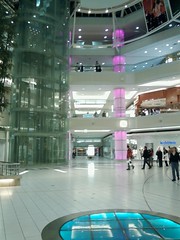 Through a chain of links from Kottke to Shopping Mall History to the Hudson's Bay Company website, I was interested to learn that two of the earliest shopping malls, West Vancouver's Park Royal and Seattle's Northgate, both opened in 1950 here in the relatively sleepy Pacific Northwest.
Through a chain of links from Kottke to Shopping Mall History to the Hudson's Bay Company website, I was interested to learn that two of the earliest shopping malls, West Vancouver's Park Royal and Seattle's Northgate, both opened in 1950 here in the relatively sleepy Pacific Northwest.
Even when I was a kid in the '70s, Park Royal was one of the biggest and most interesting malls in Greater Vancouver—I'd travel there quite regularly with my mother, even though it was at least a half-hour freeway drive across a bridge and there were several other shopping centres closer to us.
At that time, American TV also dominated our channel selection, so I often heard about Northgate (and its companion, Southcenter) on U.S. advertising, but I never visited until this year. (There was nothing special about Northgate except the dedicated shopping cart escalator inside Target.)
In the '80s, British Columbia's biggest mall complex, Metrotown, arose a mere ten-minute walk from our house, growing like kudzu around a Sears store that has been there for well over 50 years, and that used to be the only destination shopping in the area when I was young. On vacation, we've encountered people from the Seattle area who travel here just to shop at Metrotown, which seems weird since to me it's just our local mall.
Unlike monsters such as Mall of America or West Edmonton Mall, no shopping centre in our area has an indoor wave pool or amusement park, just lots of stores and restaurants. Yet despite decades of renovations and expansions, when you visit places like Park Royal or the Metrotown Sears or Northgate, you can see the design legacy of their origins. Something is still fundamentally 1950s about the parts that remain.
I bet some of them have time capsules still waiting to be opened.
Labels: design, history, memories, seattle, shopping, vancouver
05 July 2008
East Van, East Side, East End, West Van, West Side, West End?
 There are things you know about your home town that you don't even know that you know. For example, I was born and grew up in Greater Vancouver, and I instinctively understand the bizarro terminology for parts of the city that must seem simply insane to anyone just arriving here.
There are things you know about your home town that you don't even know that you know. For example, I was born and grew up in Greater Vancouver, and I instinctively understand the bizarro terminology for parts of the city that must seem simply insane to anyone just arriving here.
Here's what I mean. East Vancouver, the East End, and the East Side are all the same thing—essentially the entire portion of the City of Vancouver east of Quebec Street (or, depending on where you are and how you define it, maybe Cambie Street or Main Street, which are both close by). Cool, fine, makes sense.
However, West Vancouver, the West End, and the West Side all represent completely different places. West Vancouver is actually a different city (Canada's richest, by the way), across Burrard Inlet northwest of Vancouver proper. The West End is part of the City of Vancouver, but a tiny part, the dense residential area of the downtown peninsula northwest of Burrard Street and southeast of Stanley Park (and not usually including stuff north of Georgia Street near Coal Harbour).
The West Side is different again, basically the converse of the East Side (or East End, or East Van)—the large swath of the city west of Quebec Street (or Cambie, or Main), extending out to Point Grey and the ocean. The Downtown East Side (or Downtown Eastside, one word) is the opposite (in many ways) of the West End and the West Side and West Vancouver. It is on the opposite side of downtown from the West End, and is Canada's poorest neighbourhood. In a sane world, it would be the East End compared to the West End, or alternatively the West End would be the Downtown Westside. But no.
Then we get to north and south. North Vancouver is again a different city (actually two—a City and a District—and no, I don't understand that either), again across Burrard Inlet, next to West Vancouver. Yes, West Vancouver and North Vancouver are next to each other, west to east, with neither one further north or south than the other, and together they constitute (get this) the North Shore.
(By the way, those of you used to the North Shore being on Oahu in Hawaii will be even further confused. In Hawaii, the North Shore means the northernmost land area of the island of Oahu, facing north. It is, in other words, the shore on the north side of the island, and is part of Oahu. In Vancouver, the North Shore is the southernmost land area to the north of the city itself, facing south across the inlet. It is the shore on the north side of the water, and is not part of Vancouver itself—even when we call it Vancouver's North Shore.)
South Vancouver encompasses parts of both the West Side and the East Side/East Van/East End. The southern parts, quite logically. Sometimes you also hear South Slope, or rarely the South Side, since most of that region slopes down from the high ground running east to west across the city. No one ever calls it the South End, and there is no North End or North Side either. There is also no South Shore.
There is a formal definition for Greater Vancouver (a.k.a. Metro Vancouver), encompassing suburban municipalities around, and mostly east of, the City of Vancouver, and which pay certain taxes to the Metro Vancouver district government (formerly the Greater Vancouver Regional District). But many locals extend that definition to reach out into the Fraser Valley to the east, and sometimes up Howe Sound to Squamish in the north these days. The boundaries expand as people commute farther and farther.
Finally, one more thing about the east-west dichotomy. Traditionally, Vancouver's East Side has been working class and the West Side more upper class, in broad terms. But these days, no one with a single (or double) working-class income could afford a new house anywhere in the City of Vancouver, because it's easy to find single-family detached homes approaching a million dollars, even in the most distant corners of East Van. That's what those expanding commuter boundaries are all about. Without help from family, existing real estate, or obscenely high incomes, first-time home buyers wanting to live in Vancouver itself are looking at a condominium or townhouse (and possibly an older one) at best.
In part because of that, the City of Surrey, part of Metro Vancouver, will likely exceed Vancouver's population in the next decade or so, and already covers a much larger area, but we won't be calling this place Metro Surrey anytime soon.
Labels: history, home, vancouver
30 June 2008
Rock from on high
One hundred years ago today, St. Petersburg, Russia, would have been annihilated by an enormous explosion—if the detonation had occurred less than five hours later than it actually did. But as it turned out, the event happened thousands of kilometres further east, smack dab in the middle of Siberia. St. Petersburg was lucky, saved by the rotation of the earth.
The fireball now known as the Tunguska Event was the mid-air explosion of an extraterrestrial object of some sort (link via PZ Myers), likely a meteorite or fragment of a comet—fairly big, perhaps 50 or 60 metres in diameter, like a condominium tower falling from the sky at several thousand kilometres per hour—which disintegrated violently in the atmosphere. The place is still a remote Siberian forest, several hundred kilometres northwest of Lake Baikal. Trees that fell then still lie on the ground a century later. The heat created microscopic glass beads in the soil. There would be no airburst of similar magnitude until the invention of the hydrogen bomb.
It took almost 20 years for a Soviet scientific expedition, led by Leonid Kulik, to visit the area and survey the still-extensive damage in 1927: while there was no obvious crater, trees had been stripped of their branches and bark, as well as flattened by the shock wave, in a region some 50 km wide. Had the Tunguska Event occurred in a populated area, tens or hundreds of thousands of people might have died.
It was nothing, of course, compared to other impact events on earth, such as those linked with mass extinctions in the more distant past. But I still wouldn't have wanted to be anywhere near it.
Incidentally, Tunguska shares its centenary not only with my 39th birthday today, but also with something else I'd probably prefer to steer clear of: the 45th birthday of Yngwie Malmsteen.
Labels: anniversary, astronomy, birthday, disaster, guitar, history
Geeky geeky geeky
Over at the Your Geekiest Photos photo pool that I set up at Flickr a few months ago, we have accumulated quite a collection, but it could be bigger. Don't forget to join up and add your own.
Dig deep into your archives—it would make a nice birthday present for me.
Labels: geekery, history, memories, photography
